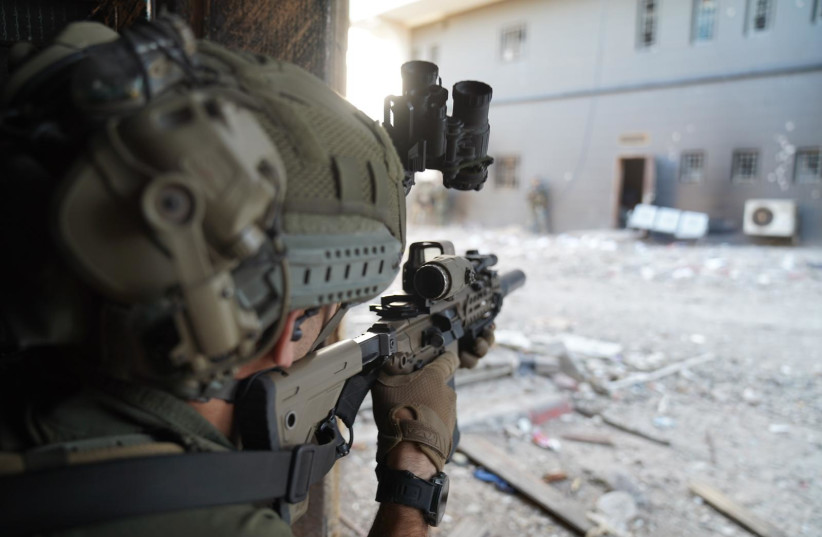The IDF on Monday successfully withdrew from Shifa Hospital in northern Gaza, after an intense two-week battle. The operation to take control of it from over a thousand terrorists was successful partly due to the direct participation of the Shayetet 13 special forces unit.
Although Shayetet 13 has special additional training for combat at sea, it has also been used for decades for special high-profile or precision operations on land.
The war is the first time that “Israel’s Navy SEALs” became an additional long-arm of a regular infantry division, Division 162, commanded by Brig.-Gen. Itzik Cohen.
After nearly six months of fighting together, Cohen said he has a fantastic operational relationship now with Col. “A”, the commander of Shayetet 13.
One of its early missions in the war – taking over the Qatar hospital building – is now viewed as having emerged as a paradigm shift that became a model for the takeovers of many other Gaza hospitals that terrorists were using as command centers, in violation of the laws of war.

Returning to Shifa hospital
This violation was so pronounced during the recent two-week re-invasion of Shifa – after the IDF took it over in mid-November – that now, top officers do not even refer to Shifa as a “hospital,” but as a “compound,” reflecting the belief that it was not so much an abused hospital, as it was a command center with some hospital camouflage built around it.
Military sources described how field intelligence from the Shin Bet (Israel Security Agency), Division 162, and Shayetet 13 worked together to track the growing number of terrorists building a new large command center at Shifa.
The three centers of gravity for the terrorists were: the Qatar facility, the emergency room, and the maternity center – though there were terrorists in every single one of the sprawling hospital’s buildings.
According to the IDF, they gave the mostly 6,200 civilians and terrorists two separate opportunities to surrender.
The IDF said it preferred to avoid violence, along with the “win” of capturing and interrogating Hamas officials to obtain intelligence.
Shayetet 13 was the first into the Shifa area, nailing down and isolating the area in a mere 15 minutes at the start of the operation. The same forces were then the first, after the IDF’s much larger divisional forces reinforced the siege zone, to penetrate the specific hospital buildings where the most Hamas terrorists were expected to be.
According to the military, Hamas not only fired mortars at the IDF in disregard of the harm to the hospital buildings but also used patients and doctors as human shields.
The IDF said that Shayetet 13’s special training could be credited with the success with which they managed to evacuate the patients and doctors without them being harmed, even as they fought off the Hamas terrorists.
These patients and doctors were moved to a pre-setup field hospital.
The IDF added that the terrorists who did not surrender fought very hard and several of them exploded themselves with grenades to try to kill nearby IDF forces.
Although no Shayetet 13 soldiers were killed by this, there were six wounded naval commandos and two more Nahal soldiers were also wounded by these tactics.
There were also some deaths among regular infantry in the fighting in areas near Shifa.
The IDF believes that despite the terrorists’ return to Shifa after the first IDF takeover in November, this recent operation was the most damaging operation to Hamas, and will prevent it from risking a return to Shifa a third time in any significant numbers.
Still, the IDF said the war is far from over and that it will need to continue to actively pursue Hamas in a variety of areas once it regroups.
Palestinian media reported that the hospital had sustained widespread burning and destruction, and consequently was rendered totally out of service.
Citing local sources, reports claimed that the IDF did this by demolishing multiple floors and burning the rest of the facility, along with surrounding buildings.
A week into the operation at Shifa, IDF spokesperson R.-Adm. Daniel Hagari said that Hamas fired mortars at the hospital complex. In an update posted on its Telegram channel, Hamas corroborated the statement shortly thereafter.
The military announced on Monday that St.-Sgt. Nadav Cohen, 20, was killed in the southern Gaza Strip on Sunday.
It said that in central Gaza, a combat helicopter had attacked a Hamas military compound that had been booby-trapped against Israeli forces, using it to observe IDF troops. The helicopter struck another Hamas compound.
IAF aircraft used several precision strikes to target terror elements in Gaza that posed threats to Israeli troops, it added.
Additionally, commando troops operating in the Al-Amal area of Khan Yunis in southern Gaza killed terrorists. They also apprehended terrorists and located weapons and explosives during searches of the area.
Sam Halpern, Jerusalem Post Staff, and Reuters contributed to this report.
